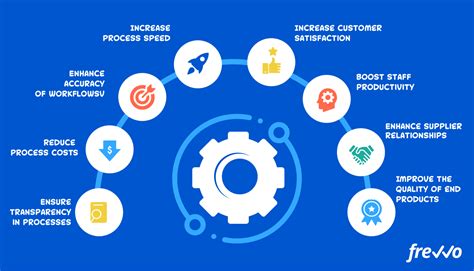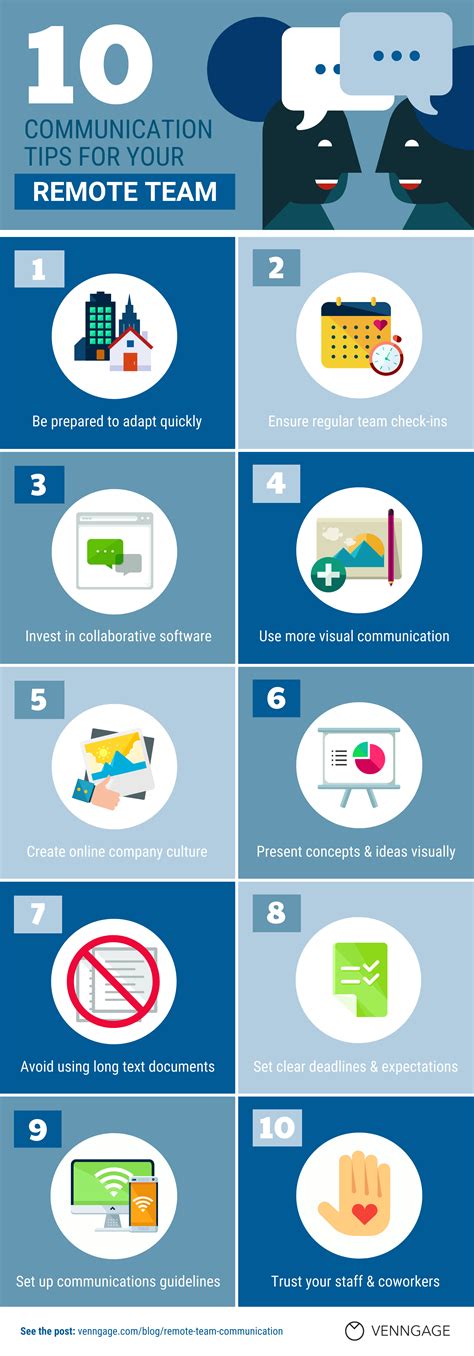With the modern world rapidly embracing remote work, it is essential for professionals to find effective strategies to enhance their productivity outside of the traditional office environment. By employing innovative methods and adapting to the unique challenges of remote work, individuals can optimize their workflow and achieve outstanding results.
One invaluable approach to remote work productivity is refining time management skills. It involves carefully prioritizing tasks, setting clear goals, and maximizing efficiency. By identifying and focusing on the most important assignments, professionals can ensure that their efforts are dedicated to the activities that will yield the greatest impact.
In addition to efficient time management, establishing a conducive work environment is crucial for remote workers. Creating a dedicated workspace, free from distractions, can significantly enhance concentration and overall productivity. By minimizing interruptions and establishing clear boundaries between work and personal life, remote professionals can foster an environment that promotes focus and accomplishment.
Creating an Effective Home Workspace for Maximum Efficiency

Setting up a conducive and well-equipped workspace is crucial when it comes to optimizing productivity while working remotely. By crafting a dedicated area in your home that is designed to promote focus, organization, and comfort, you can significantly enhance your ability to stay focused and achieve your goals without distractions.
Here are some key elements to consider when creating a productive workspace at home:
| 1. Purposeful Design: | Design your workspace in a way that supports your work requirements and preferences. Consider factors such as lighting, ergonomic furniture, and a clutter-free environment to ensure maximum comfort and functionality. |
| 2. Personalization: | Add personal touches to your workspace to make it feel inspiring and motivational. Incorporate elements like plants, artwork, or meaningful objects that resonate with you and create a positive ambiance. |
| 3. Proper Equipment: | Invest in essential equipment, such as a reliable computer, high-speed internet connection, noise-canceling headphones, and any other tools specific to your line of work. Ensuring that you have the necessary tools will promote efficiency and minimize technical disruptions. |
| 4. Organization: | Maintain a well-organized workspace to avoid distractions and improve focus. Utilize storage solutions, such as filing cabinets, shelves, or desk organizers, to keep your supplies, documents, and materials neatly arranged and easily accessible. |
| 5. Minimize Distractions: | Identify potential distractions in your environment and take steps to minimize their impact on your productivity. This could involve creating boundaries with household members, turning off notifications on your devices, or using noise-cancellation techniques to block out external noise. |
| 6. Comfort: | Ensure that your workspace is comfortable and supports your physical well-being. Invest in an ergonomic chair, use proper desk height, and consider incorporating standing or walking options to avoid prolonged sitting. |
| 7. Time Management: | Implement effective time management techniques to optimize your work routine. Utilize productivity apps, set clear goals and deadlines, and establish a schedule that aligns with your peak performance times. |
Taking the time to intentionally design and organize your home workspace can significantly contribute to your overall productivity and success as a remote worker. By creating a space that is conducive to focus, comfort, and efficiency, you can maximize your output and achieve your professional goals with ease.
Establishing a Consistent Schedule and Workflow
Creating a structured routine is essential for optimizing productivity while working remotely. By establishing a consistent schedule and workflow, individuals can effectively manage their time, stay focused, and maintain a healthy work-life balance.
One effective strategy is to start each day by defining clear goals and priorities. This could involve creating a to-do list or utilizing project management tools to stay organized. By setting objectives for the day, individuals can better prioritize tasks and allocate their time accordingly.
Avoiding distractions is another crucial aspect of establishing a routine. This includes minimizing interruptions from external factors, such as turning off notifications on electronic devices. Additionally, dedicating a specific workspace separate from personal areas can help maintain concentration and create a mental boundary between work and leisure.
Regular breaks are necessary to prevent burnout and maintain focus throughout the day. By incorporating short breaks into the routine, individuals can recharge their energy, stretch, and engage in activities that promote relaxation and stress reduction.
Lastly, maintaining a consistent work schedule and adhering to it as closely as possible can foster discipline and increase productivity. Establishing specific work hours, sticking to designated breaks, and avoiding the temptation to overwork can lead to a healthier work routine and better overall output.
- Define goals and priorities at the start of each day
- Minimize distractions and create a dedicated workspace
- Take regular breaks to prevent burnout
- Maintain a consistent work schedule
Setting Clear Goals and Priorities

In order to maximize productivity and efficiency while working remotely, it is crucial to establish clear goals and priorities. By defining what needs to be accomplished and determining the most important tasks, individuals can focus their efforts and ensure they are working towards meaningful outcomes.
Defining clear goals provides a sense of direction and purpose. It allows remote workers to better understand what they are working towards and helps them stay motivated and focused. Setting goals also helps in measuring progress and evaluating the effectiveness of one's work.
Identifying priorities is equally important. It involves determining which tasks or projects should be given precedence over others. This helps in managing time effectively and enables remote workers to allocate their energy and resources towards the most critical and impactful activities.
When setting goals and priorities for remote work, it is essential to make them specific, measurable, achievable, relevant, and time-bound (SMART). This ensures that the objectives are clear, realistic, and can be effectively tracked and evaluated.
Additionally, communicating these goals and priorities to teammates and supervisors is crucial for fostering collaboration and aligning efforts. Transparent communication helps in avoiding confusion, clarifying expectations, and ensuring that everyone is on the same page.
To enhance productivity while working remotely, individuals should regularly reassess their goals and priorities. As circumstances change and new tasks arise, it is important to adjust and realign objectives accordingly. Regularly reviewing and updating goals allows for flexibility and adaptability in managing remote work effectively.
Maximizing Focus to Enhance Efficiency
When working remotely, it is crucial to create an environment that promotes deep focus and minimizes distractions. This section will provide valuable insights on ways to optimize your work setup and establish healthy habits that will boost your productivity.
- Create a dedicated workspace: Designate a specific area in your home where you can work without interruptions. This helps to mentally separate your work life from your personal life and enables you to maintain better focus.
- Establish a routine: Set a consistent schedule for your remote work, including regular break times. A structured routine can help you stay on track and reduce the temptation to deviate from your tasks.
- Eliminate digital distractions: Temporarily disconnect from social media platforms, turn off notifications, and close unrelated tabs or applications on your computer. These small actions can make a significant difference in minimizing interruptions and improving concentration.
- Prioritize tasks: Create a to-do list or use time management techniques such as the Pomodoro Technique to prioritize your tasks. Breaking your work into manageable chunks and dedicating specific time blocks to each task can enhance productivity and prevent overwhelm.
- Communicate boundaries: Clearly communicate your working hours and availability to your colleagues, friends, and family. Setting boundaries ensures that you can work uninterrupted and reduces the likelihood of distractions.
- Take strategic breaks: Regularly schedule short breaks during your workday. Engage in activities that help you relax and recharge, such as stretching, meditating, or going for a short walk. These breaks can help improve focus and prevent mental exhaustion.
By implementing these strategies, you can create an environment conducive to deep focus, limit distractions, and increase your productivity while working remotely.
Enhancing Efficiency with Productivity Tools and Software

Discover the potential of productivity tools and software to maximize your remote work productivity. By leveraging cutting-edge technologies and innovative solutions, you can streamline workflows, increase collaboration, and optimize time management practices.
Implementing the right set of productivity tools can significantly enhance your remote work experience. These tools offer a range of features and functionalities tailored to meet the demands of modern professionals. From task management and communication platforms to project tracking and time-tracking tools, there is an extensive selection of options available.
One of the key advantages of utilizing productivity tools is the ability to centralize tasks and increase visibility. With a unified platform, you can easily assign and monitor tasks, maintain clear deadlines, and track progress in real time. This not only improves individual productivity but also promotes team collaboration and accountability.
Effective communication is crucial in remote work environments, and productivity tools can facilitate seamless interactions. Whether through instant messaging, video conferencing, or virtual collaboration spaces, these tools offer efficient methods to connect and engage with remote team members. Enhancing communication channels fosters better understanding, promotes effective collaboration, and prevents miscommunication.
Moreover, utilizing productivity tools can help optimize time management and minimize distractions. Many solutions provide features such as time tracking, activity monitoring, and reminders to keep you focused and on track. By prioritizing tasks and creating personalized schedules, you can better manage your workload and improve overall efficiency.
Ultimately, making informed choices and utilizing the right productivity tools and software can have a profound impact on boosting remote work productivity. By harnessing the power of technology, you can optimize workflows, enhance collaboration, and achieve optimal performance in the virtual workspace.
Taking Regular Breaks and Practicing Self-Care
In today's fast-paced work environment, it is crucial to prioritize one's well-being and maintain a healthy work-life balance. This section explores the importance of taking regular breaks and practicing self-care while working remotely.
1. Prioritize Rest:
- Allow yourself to take short breaks throughout the day to recharge and refresh your mind.
- Avoid working for long hours without breaks, as this can lead to burnout and decreased productivity.
- Engage in activities that promote relaxation, such as mindfulness exercises or taking a walk.
2. Establish Boundaries:
- Set clear boundaries between work and personal life to avoid overworking.
- Define specific work hours and communicate them with your colleagues or clients.
- Avoid checking work-related emails or messages outside of these designated hours.
3. Practice Self-Care:
- Take care of your physical health by ensuring you have a comfortable workspace and practicing good ergonomics.
- Take breaks to stretch or engage in light exercises to prevent physical strain.
- Nurture your mental well-being by engaging in activities you enjoy, such as hobbies or spending time with loved ones.
- Practice self-compassion and avoid harsh self-criticism when facing challenges or setbacks.
Remember, regular breaks and self-care practices are essential not only for your productivity but also for your overall well-being. By prioritizing rest and implementing healthy boundaries, you can maintain a sustainable and fulfilling remote work lifestyle.
Effectively Communicating and Collaborating with Remote Team Members

One of the key challenges of remote work is ensuring effective communication and collaboration among team members who are geographically dispersed. In order to maintain productivity and foster a cohesive work environment, it is important to establish strategies and tools that facilitate clear communication and seamless collaboration.
Establishing Clear Communication Channels:
When working remotely, it is crucial to define and establish clear communication channels within the team. Depending on the preferences and needs of the team members, this could involve using a combination of email, instant messaging platforms, or project management tools. It is important to establish guidelines and expectations regarding response times and availability to ensure efficient and timely communication.
Regular Check-ins and Meetings:
In order to foster collaboration and alignment, regular check-ins and meetings should be scheduled with remote team members. This allows for real-time updates, problem-solving discussions, and the opportunity to address any concerns or challenges. Video conferencing tools can be utilized to create a more personalized and interactive experience, promoting engagement and effective communication.
Use of Collaboration Tools:
Collaboration tools enable remote team members to work together on shared projects and tasks, regardless of their physical location. These tools can include online document sharing platforms, project management software, or virtual whiteboards. By utilizing such tools, team members can collaborate in real-time, provide feedback, and track progress, fostering a sense of teamwork and enhancing productivity.
Establishing Remote Work Principles:
It is important to establish remote work principles and guidelines to ensure everyone is on the same page. This can include defining expectations for availability, response times, and setting boundaries between work and personal life. Generating a shared understanding of remote work dynamics creates a culture of transparency, trust, and collaboration among team members.
Encouraging Open and Transparent Communication:
Emphasizing the value of open and transparent communication is essential in effectively collaborating with remote team members. Encourage team members to share their thoughts, provide feedback, and voice any concerns they may have. This fosters a sense of inclusivity and ensures that everyone feels heard and understood, allowing for more productive and harmonious remote teamwork.
In conclusion, effectively communicating and collaborating with remote team members is essential for maintaining productivity and establishing a cohesive work environment. By establishing clear communication channels, conducting regular check-ins and meetings, utilizing collaboration tools, establishing remote work principles, and encouraging open and transparent communication, teams can overcome the challenges of remote work and maximize their productivity and success.



